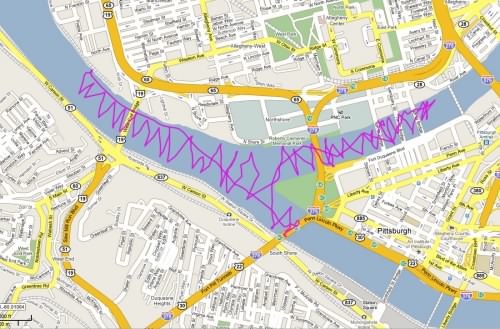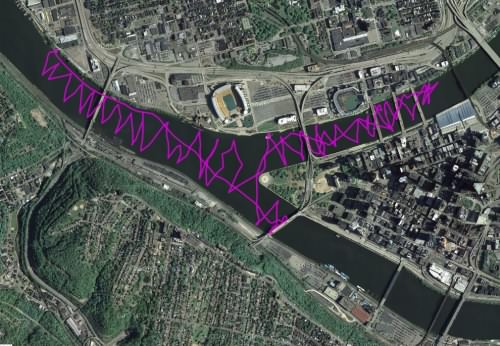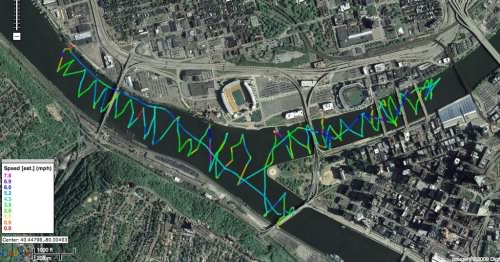Against the Current, Against the Wind
September 6, 2009
Sailing on the river was becoming so comfortable and routine that memories of my first failed attempts were fading fast. Although it now seems like eons, it was only a few months ago in May that I'd twice put into the rivers and not been able to advance against the current from my starting point at the Newport Marina to the Point. (See here and here.)
Those two experiences had taught me a lot. Both times I had tried to sail against the current and wind at the same time. That, I'd learned, is not easy. And not knowing the boat well compounded the problem. These failures had made me timid and I had only put into the water afterwards if the winds had a good Westerly component that would blow against the river current.
Now it was time to exorcise the demons that had been haunting me since May. Today the winds were blowing from the East; that is, ESE to be precise. So they blew with the river currents. But now the river currents had dropped. The Allegheny River always seemed to have the strongest current. It had dropped to the lowest levels I could recall for the entire summer.
The graph at the US Geological Survey website showed things nicely: (Click for current data.)
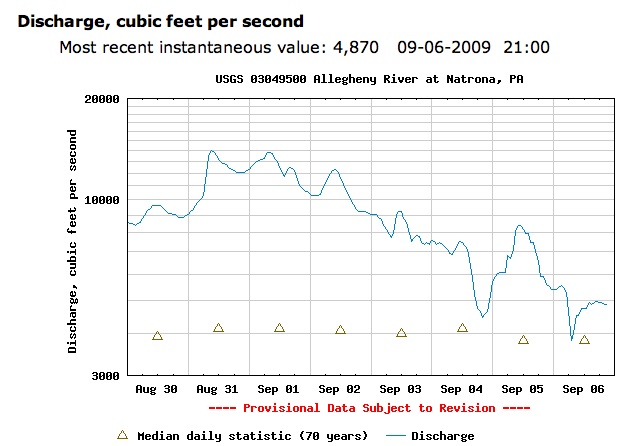
For the last two months of the summer, the flows had fluctuated roughly between 10,000 and 20,000 cubic feet per second, well above the historical averages of around 5,000 and at times topping 30,000. Today, finally, it had dropped to 5,000 cubic feet per second, which was historically the common figure over the last 70 years. That translated into a slow crawl when I inspected the river on my bicycle ride to the marina. And there was a similar crawl on the Ohio River at the marina. (The discharge scale is logarithmic, which means that when the curve is higher, is represents a lot more flow than on a normal graph.)
For completeness, here is the graph of the flows on the Mon, It showed very low flows: (Click for current data.)
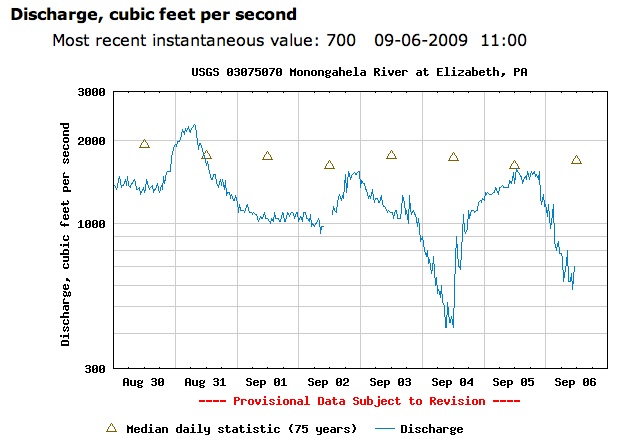
These contributed much less to the overall flow on the Ohio River.
The winds were forecast to be 9 mph from the ESE. On my bicycle ride over to the marina, I used my wind gauge to check the forecast. It showed roughly Easterly winds fluctuating between 4 and 8 mph at the Point. At the marina, the winds seemed to be pretty steady on the Ohio and in the same range. Since an Easterly wind can blow along the length of the Ohio River, I surmised that the hills on the southern bank were not obstructing the flow.
That was a relief. What had defeated me before was that the wind was so erratic that I needed to keep resetting the sail to accommodate changing wind direction; and then the wind would drop completely, leaving me to be washed back downstream by the current. Today it looked like I should have enough steady wind to overcome the current, even if I was tacking straight into the wind, the hardest direction to sail.
With only a little trepidation, I put the boat into the water. The wind was steady. It pulled the boat easily along at comfortable speeds of 3 to 5 miles per hour and perhaps sometimes more. That was good. I needed to tack directly into the wind, so every bit of speed helped. The GPS track shows my progress, starting at the far left, the Western end. Unlike tracks from earlier days, the winds are blowing from the right, the East, so that the zig-zags trace my progress upstream towards the point.
It was laborious sailing into the wind and current. The tacking proceeded. Across the river and back; across and back. With each return I had gained only slightly, typically 100 yards each time. While the current was weak, it look a toll. At first I wondered if I was making any progress at all. But then with each return came a small advance and I was a little closer to the point. After 20 minutes, I passed the West End Bridge. It is the gateway to downtown Pittsburgh. When I pass it, I relax. I am entering friendlier waters and I know that I will soon be at the Point. In the end, I needed one hour and ten minutes to tack up to the Point, which I grazed past just as a collection of kayakers met at the same spot. I could not dock there. Docking on the point was prohibited today. The reason, I guessed, was connected with the huge stage being erected on the Point.
As I tacked back and forth, the sailing was comfortable. The winds were just right: strong enough to keep me moving, but not too strong to make tacking hard. I didn't miss a single tack on my voyage to the point. Now and again the wind picked up and my boat surged forward. On one surge, I managed to look down at my GPS receiver and saw a sustained 9.5 mph speed, possibly the fastest I'd measured. This GPS track is color coded to show speeds.
There were lots of events around the rivers. At Heinz Field, they were into the third day of a rib cook off. Eve and I had visited it on Friday night, chaining our bicyles to a lamppost. We passed vendor after vendor, all displaying trophies and awards for the best ribs, with many displays 20 and 30 feet high. Unfortunately the lines at each vendor were roughly as long. There was also a baseball game at PNC Park. Its erratic mix of music drifted out over the trail. When I had cycled past, they were playing Carl Orf's "O Fortuna." All this activity brought plenty of boats and they were clusted two and three boats deep at the available moorings on the Northern shore of the Allegheny and Ohio. I had snapped a photo of them on my ride over:
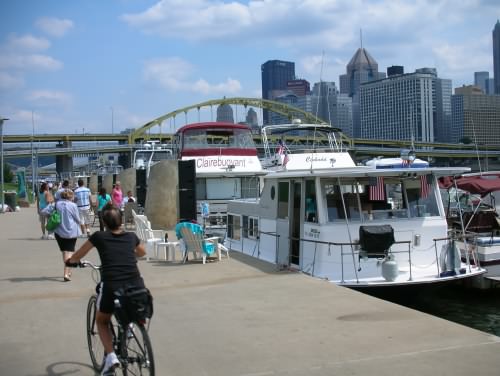
Now on the water I was weaving my way past these boats. Every now and again there is a little kink in the GPS track. Most likely I am navigating around a boat or turning into a wake. The no wake zone starts at the West End Bridge. Until then, passing boats may leave quite substantial wakes that my little boat must plow over. After one passed a little too close, I was tossed in its wake and momentarily smelled cigar smoke. It was an extraordinarily dissonant experience. All my senses but one surrounded me with river and water and sail; and my sense of smell threw me momentarily into a dark, wood-panelled club.

The big riverboats were out in force, attracted by all these events. Since there was ample wind, I was no longer bothered by them at all. I had been told of the great danger they pose for hapless sailors who might somehow get caught under their bows. That now seemed less likely. It was a possibility in principle, but unlikely to happen in practice, given a little prudence by sailors and, if there is an emergency, a modicum of course change by the big ship. A little sailboat is, in the end, a little target that might actually be hard to hit. (Nonetheless, the big barges that also navigate these waters are best given wide berth.)
At one point I passed a power boat, most of whose occupants had slid into the cool water, holding their beer cans high in the air. As I passed, it was picture perfect. About 500 yard downstream, the Gateway Clipper was bearing down directly on them. The still had a few minutes to reboard and move. I would have stopped for a photo, but my hands were full with the wind, the tiller and mainsheet. Directly in the path of a big ship seemed a poor place to heave to (=setting the sail and tiller so the boat stops dead in the water). I sailed on thinking that if this sort of behavior does not routinely lead to great river catastrophes, then surely the danger is exaggerated.
After proceeding further up the Allegheny, I docked at the only available place: the southern shore near the Tenth Street By-pass. The dock was high and rusty and my little boat seemed dwarfed by it. It was warm--high 70sF--so I drank some water and ate a protein bar. Then I took some photos.
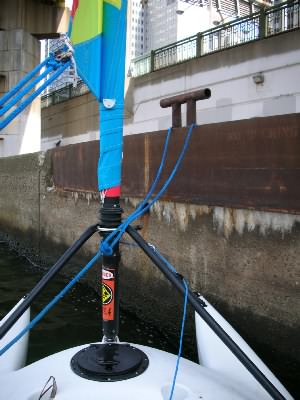
Looking along the dock towards the Point, I could see another boat that I assumed could not find a mooring close to the popular events. Or perhaps they just wanted to a little peace away from all the noise and activity.
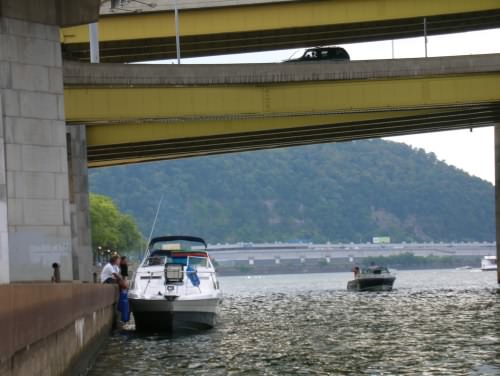
Up the river, I could see my three favorite bridges, the bridges at 6th, 7th and 9th Streets.
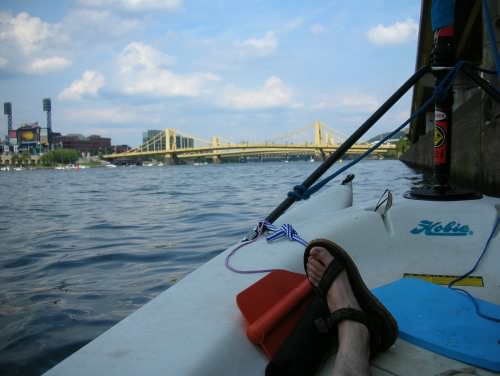
A little further over was PNC Park, visible over the water. The high dock was protecting the water near me from the wind, so it had gone quite glassy.
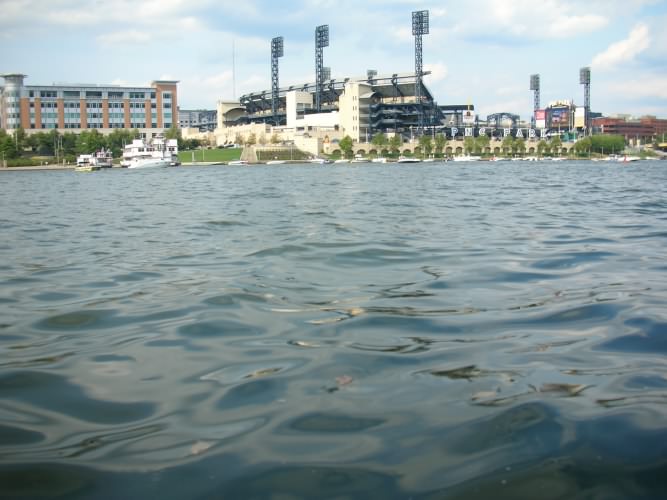
I could see the game in the huge digital monitor and its sounds had followed me up and down the river.
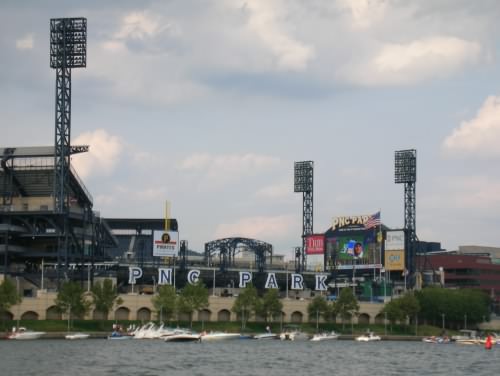
Directly across the river was a docked riverboat that had ferried spectators to the baseball game and, next to it, the popular fountain, overflowing with water and children.
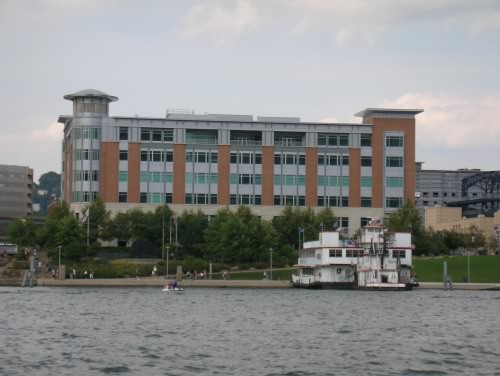
Looking further downstream, across the water to Heinz Field, I could see the boats attracted by the sun and the rib cook off, all framed by the majestic arch of the Duquesne Bridge.
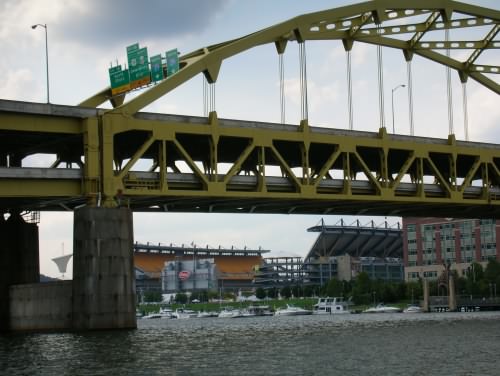
From this bobbing perch, I returned Eve's phone call. She was heading off to a coffee shop to write and would not be home for a while. (She's writing for her wonderful blog, utterly-opinionated. Eve: note the gratuitous, free plug.) Well refreshed and in no special hurry, I put back into the water and sailed on. These were perfect conditions. At that moment, as I threaded my way past happy boaters and kayakers, under magnificent steel bridges and past the city skyline, I could not image where else in the world I would want to be.
My course took me up to the Convention Center. The stretch of water opposite it seemed to form an impassable barrier. I tacked to and fro a few times and found that, on each tack, the wind changed direction sufficiently for the course that I thought would advance me upstream now to be inaccessible. I assumed that the great mass of the Convention Center was sufficiently deflecting the wind to give it very different directions in different parts of the river. It was, I decided, not worth the effort of beating this little wind trap.
With the wind now behind me, I sailed easily back to the Point, taking only 15 minutes. This was not a sail I wanted to end--I was having too much fun. So I rounded the point and decided to make my way against the wind up the Mon. When I reached the Fort Pitt Bridge, however, a fierce and gusty wind blew down the Mon. That made tacking hard, once again, and I needed to jibe to make my tacks. As I looked into that wind, I began to think that it was getting late. It was past 5pm. Sailing back to my dock now seemed more appealing that fighting against those gusts. I turned and reefed the sail. With the strong wind behind me, I did not need its full area to move at a comfortable speed. There was no tacking needed since my sail just caught the wind like a bag. It took a mere 15 minutes now to go from the Point to the marina.
Winds on the rivers can be erratic, depending on what obstructs them. However one thing was becoming quite clear from this and my other river sails. As long as the winds are blowing roughly from the East or West, they tend to get channeled into the river course, so that they blow along the river, either with or against the current. That means that most sailing up or down the river will be laborious tacking, to and fro; or an easy run with the wind directly behind.
As I rode my bike home, I once again marveled at the energy of Pittsburgh's riverfront. There were people and boats everywhere: first the new casino, with diners an arm's length away in outdoor seating by the trail; and then Heinz Field and the crowds who had come for its ribs; and then then baseball game at PNC Park. I arrived home well before Eve, so there was still time for my other favorite river activity. I put on my running shoes and headed off for an hour's run on the river trails. I took my favorite run up the Allegheny past Washington's Landing.
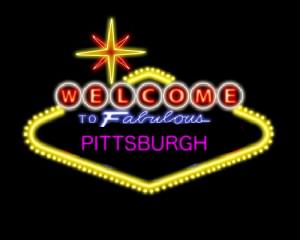
When we plan vacations, we look for places where we can do the things we love. By that standard I am in the finest vacation resort when I am at home in downtown Pittsburgh. For I stepped out my door and spent the afternoon immersed in really interesting sailing; and then I ran on the most beautiful river trails I've ever seen; and then I am home. Dinner was takeout Chinese food from the little restaurant opposite us, perhaps 100 yards away. We are regulars, so most of our order is not on the menu.
John D. Norton
Back to main
